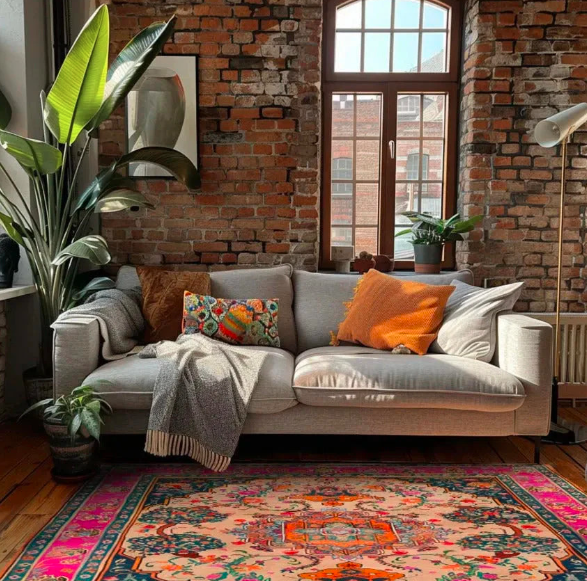
A family-friendly home balances style with function, creating spaces that are comfortable, adaptable, and durable for every age. With flexible layouts and furniture, rooms can shift from play to relaxation with ease, fostering both connection and individuality. More than a place to live, a well-designed home grows with your family, offering comfort, belonging, and lasting memories.
Designing Versatile Family Spaces
Creating a family space that adapts to different activities and ages involves strategic planning. Consider open-concept designs, flexible furniture, and multi-functional rooms to accommodate shifts in family needs and lifestyle.
Open-Concept Living Areas
Open-concept living areas foster interaction, keeping family members connected. By removing walls, you create a sense of spaciousness and flow between the kitchen, dining, and living areas. This layout makes it easy for you to keep an eye on the kids while cooking or for friends to mingle freely during gatherings.
To define spaces within an open layout, use area rugs or furniture placement. For seasonal style updates, many homeowners look for autumn and winter rug inspiration to bring warmth and texture into shared spaces. A large sectional can divide the living area from the dining space effectively. Lighting plays a crucial role—use pendant lights or floor lamps to highlight areas like reading nooks or dining tables.
Flexible Furniture Solutions
Investing in flexible furniture enhances your ability to adapt spaces over time. Consider modular sofas, which can be reconfigured to fit different room layouts or group sizes. Extendable dining tables are perfect for everyday use and can accommodate larger groups when needed.
Storage is another factor—choose pieces like ottomans or benches with built-in compartments to keep spaces tidy and toys within easy reach. Multi-use furniture ensures rooms adapt as your family’s needs evolve, maintaining both functionality and style.
Multi-Functional Rooms
Designing a room for multiple purposes reduces clutter and maximizes living space. A home office can double as a guest room with a fold-away bed or a sofa bed. Wall-mounted desks save floor space and can be closed when not in use, making the room feel more open.
In a kid’s room, add a study area that doubles as a craft zone, with adjustable shelving to grow with your child. Strategic layouts and furniture create rooms that transition smoothly between functions, aligning with daily life.
Safety and Accessibility for Every Age
When designing a home for a family, it’s crucial to focus on safety and accessibility features tailored for all ages. From childproofing young children’s areas to considering mobility needs for seniors, thoughtful design promotes well-being.
Childproofing and Secure Features
Keeping young ones safe requires more than just parental oversight. Childproofing essentials include installing safety gates, securing furniture to walls, and using outlet covers to prevent electrical accidents. Consider using corner protectors on sharp table edges.
Window locks and cordless blinds help prevent falls or strangulation risks. Choose furniture with rounded edges to minimize injury potential. In the kitchen, cabinet latches restrict access to dangerous items like knives and cleaners. Organize toys in low bins to prevent climbing accidents, creating a safe space for kids to explore.
Accessible Layouts for Seniors
Designing a home layout with seniors in mind involves creating an environment they can navigate easily. Wide doorways and hallways accommodate mobility aids like wheelchairs or walkers. Consider installing no-step entrances for smooth transition zones.
Lever-style door handles replace traditional doorknobs, which are often challenging for those with limited hand strength. Adjustable or lowered countertops in kitchens and bathrooms facilitate use from a seated position. Grab bars in bathrooms and along stairways offer extra support. These tweaks maintain a welcoming environment for senior family members.
Slip-Resistant Flooring Choices
Flooring choices are vital in maintaining a safe household. Areas prone to spills or moisture, such as kitchens and bathrooms, benefit most from slip-resistant flooring materials. Textured tiles, luxury vinyl tiles, or rubber flooring offer excellent traction.
Carpeting should have non-slip backing or anchoring tape, with smooth transitions between flooring types to reduce hazards. In mudrooms and entryways, consider mats with skid-resistant features. This attention to detail minimizes the risk of slips, ensuring comfort and safety for the entire family.
Inspiring Connection and Personal Retreats
Creating spaces that foster both connection and individuality in your home can greatly enhance family life. Balancing communal areas with private retreats ensures every family member has room to connect and recharge.
Family Gathering Zones
Designing areas for family gatherings can transform your home into a hub for interaction and shared experiences. Add a spacious living room with sofas or bean bags to invite everyone to relax together. A large dining table can serve as a focal point for meals and conversations.
Open floor plans can encourage movement and interaction by blending the kitchen, dining, and living spaces. Install a central island or bar stools in the kitchen to bring everyone together during meal prep.
Private Spaces for Each Family Member
While connection is key, personal retreats provide the necessary peace for relaxation and self-reflection. Create personalized spaces for each family member that cater to their unique interests. A cozy corner with books and a reading lamp might be perfect for the book lover.
A chair or small desk can transform an unused area into a retreat. For those who love music, consider soundproofing a room or setting up a small music area. Personalization is important, so get input from each family member to define their space.
Homework and Study Nooks
Dedicated study zones enhance focus and productivity for children and adults alike. Choose a quiet corner or a well-lit area to set up a desk with all necessary materials. Good lighting and comfortable seating are essential. Add shelves for easy access to books and supplies.
Younger kids benefit from a nook near family areas for supervision, while older children need quieter spots for focus. Decorate the space with quotes or personal art to make it inviting.
Personal Touches and Growing with Your Family
Designing your home to grow with your family involves thoughtful planning, focusing on adaptable storage, versatile decor choices, and ensuring spaces accommodate future needs. These elements allow your home to reflect your family’s evolving lifestyle while avoiding unnecessary renovations later.
Custom Storage Solutions
Custom storage options can transform how your family uses space. Personalized shelving systems, like adjustable units in children’s rooms, adapt as your child grows, accommodating everything from toys to more sophisticated collections. In shared living spaces, concealed storage like built-in benches or ottomans declutters without compromising style.
Consider incorporating flexible pantry units in the kitchen. Slide-out cabinets and adjustable shelves offer convenient access and can be altered as your family’s storage needs change. Use vertical space effectively, with wall-mounted cabinets or hooks that maximize available room without crowding the floor.
Easy-to-Update Decor Ideas
Choose decor that’s easy to update, allowing you to refresh your home’s look without extensive redecorating. Opt for neutral wall colors and add personality with interchangeable elements like cushions, throws, or wall art. Swapping these pieces is a quick way to reflect changing tastes or seasonal styles.
Removable wallpaper is an easy way to transform spaces and refresh a room’s ambiance. Many homeowners also explore services such as architectural visualisation London to preview design ideas and experiment with different looks before committing. In children’s rooms, choose accessories like growth charts or art displays that age well, ensuring spaces mature with them.
Future-Proofing for Changing Needs
Prepare your home for evolving family needs by incorporating flexible design elements. Multi-use furniture like sofa beds or extendable tables adapts to changing needs, from hosting guests to extra workspace. Invest in adjustable lighting, from dimmable fixtures to movable lamps, to ensure comfort and utility in various activities.
Consider future accessibility needs by installing wide doorways or choosing single-level layouts. These features can accommodate different family stages, from toddlers learning to walk to accommodating older family members. Planning for these changes early can save time and resources later, ensuring a pleasant, functional living environment for everyone.
Conclusion
A well-designed family home balances safety, flexibility, and comfort, creating spaces that adapt to changing needs while fostering connection and individuality. With thoughtful choices in layout, furniture, and decor, your home can remain both practical and inviting, growing seamlessly alongside every stage of family life.
